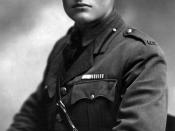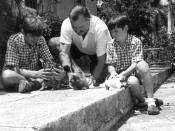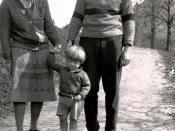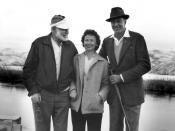Hemingway uses a variety of literary techniques to produce a sense of ambiguity in the reader in ÃÂCat in the RainÃÂ. He starts by using rain to evoke feelings such as melancholy and emptiness in the reader. He then uses techniques such as characterization, repetition and symbolisms to express feelings in the characters and to further develop the text. Through her actions and words, we may find that the American wife is probably the most pivotal character throughout the text. In fact, what seems to be a simple tale of an American couple spending a rainy afternoon inside their hotel room serves as a great metaphor for their relationship.
The starting description of the ÃÂCat in the RainÃÂ is very welcoming and lively: ÃÂThere were big palms and green benches in the public garden. In the good weather there was always an artist with his easel.
Artists liked the way the palms grew and the bright colors of the hotels facing the gardens and the sea.ÃÂ However, these positive feelings start to break apart with the description of the war monument and the rain that bring in themes such as conflict and grief: ÃÂItalians came from a long way off to look up at the war monument. It was made of bronze and glistened in the rain. It was raining. The rain dripped from the palm trees. Water stood in pools on the gravel paths.ÃÂ The rainy setting that prevails during the end of the description, along with a very simple structure, invokes a tedious, monotonous and dull feeling in the reader. ÃÂThe sea broke in a long line in the rain and slipped back down the beach to come up and break again in a long line in the rain.ÃÂ The mentioning of the sea makes the setting even emptier. Hemingway also uses repetition here to reinforce the tedious feeling. He uses the changing setting to create a sense of mystery in the text.
Not only does the rainy setting reinforce the literal ambiguity, it also reproduces the marriage tension. At first, marriage was pleasurable, but a ÃÂwarÃÂ started between George and his wife, which destroyed their love for each other. Ernest Hemingway also uses subtle symbolism to convey to the reader that the relationship between the American couple is quite clearly dysfunctional. In other words, the reader has to have a symbolic reading of the images. This symbolic imagery, hidden behind common objects, gives the story all its significance.
An example of this symbolism is in the cat. When the cat is first observed it is "crouched under one of the dripping green tables. The cat was trying to make herself so compact that she would not be dripped on." Even though the American wife is too far away to determine its gender, the cat is immediately referred to as ÃÂsheÃÂ. This immediately begins to form a link between the cat and the wife. Quickly, this link starts bringing in themes such as marriage as George proceeds to neglect his wife. This is evident not only from his sulky words but also in his lack of involvement in her want for the cat.
Characterization is used by Hemingway as a catalyst to ambiguity in ÃÂCat in the RainÃÂ. An example of this is the female character, described in two different ways: American girl and American wife. The real name is not mentioned, possibly making the character into an American stereotype. In addition, the change in the naming of the character appears to correlate to the change in mood of the character. ÃÂThe American wife stood at the window (ÃÂ )ÃÂ; ÃÂAs the American girl passed the office (ÃÂ )ÃÂ. When the character is named as American wife, she is an introverted woman, which is ÃÂstuckÃÂ to her husband. However, when she is named American girl, she manifests all her desires, like the following quote shows: ÃÂÃÂI want to pull my hair back tight and smooth and make a big knot at the back that I can feel,ÃÂ she said. ÃÂI want to have a kitty to sit on my lap and purr when I stroke herÃÂÃÂ. By doing this, Hemingway seems to split the character into two, strengthening the ambiguity of the text.
Bibliography:Short Story "Cat in the Rain" by Ernest Hemingway





